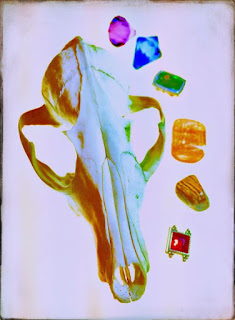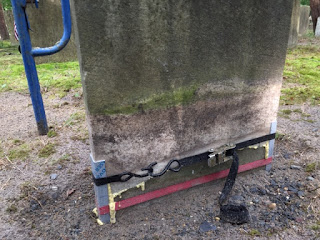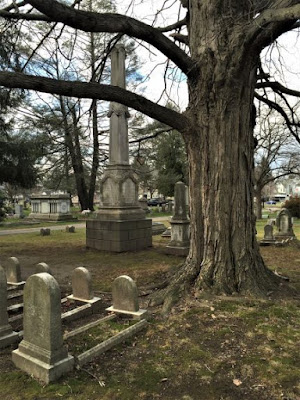Image by Michael Kauffman
“What the world needs right now is another endless musing on staying at home during the coronavirus pandemic; the C.D.C. has declared these pieces to be a symptom of COVID-19 that can be treated only by gentle snoring.” - Libby Gelman-Waxner in her New Yorker article “If You Ask Me: The Last Quarantine Think Piece” (May 18, 2020)
While I agree with the above statement, I’m still going to write this blog. As my friend Mike Spak would say, “Anything worth doing is worth overdoing.”
This past summer I was walking up the street toward my house, end of the day, coming home from work. A few neighbors were outside their homes chatting (from an appropriate COVID social distance) – I live on a tiny street of row homes in an old nineteenth-century Philadelphia neighborhood. My neighbor Michael, who lives around the block, addressed me in a relatively loud voice, “Hey Ed, I returned your skulls … left them with your wife.” Ok, that’s a wee bit embarrassing – but in a good way, lol.
I am very selective when it comes to my choice of friends – they have to be anything but normal and boring. And they say the darndest things. One time a few years back I got together after work with a friend to have a beer. We were walking down the street on a Friday evening, lots of people on the sidewalks, summer. I asked him how his day went, as he appeared to be tired out. He sighed and said, “Well, we got all six bodies out of the ground.” Couldn’t help notice the startled looks we got from those around us! Frank worked in a graveyard, and I knew he was working on a project to move some graves.
 Michael, my neighbor, is an artist. He appreciates Caravaggio, a Baroque era painter who seemed to rather enjoy painting people getting their heads chopped off. Some of his art evokes Caravaggio. Over the course of the last few years, Michael and I have each learned a bit about each others’ art. As an aside, I shared with him the fact that I pick up skulls in abandoned graveyards – everyone needs a hobby, right?
Michael, my neighbor, is an artist. He appreciates Caravaggio, a Baroque era painter who seemed to rather enjoy painting people getting their heads chopped off. Some of his art evokes Caravaggio. Over the course of the last few years, Michael and I have each learned a bit about each others’ art. As an aside, I shared with him the fact that I pick up skulls in abandoned graveyards – everyone needs a hobby, right?
Just to be clear, my skulls are not human skulls. You just don’t run across those as often as you do skulls of other animals - even in abandoned graveyards!
During the spring/summer 2020 coronavirus lockdown, Michael had been stuck in the house, so he’d spent some of that time creating art. Either he asked to borrow some of my skulls, or I offered them to him, I don’t remember exactly how that went, but he created some startlingly gorgeous photographs with them, which he planned to use as components of larger digitally collaged art work. Michael has a glorious light tent in his garage in which he does digital macrophotography. I was jealous so I had Amazon send me one. Not a garage, a light tent. An inexpensive version of his (mine is shown below).
It was probably in May that I lent Michael my skulls. May was an absurd month, full of fear and coronavirus. Lockdowns and masking. A lot of artists spent this time holed up, creating. In November, Michael shared some of the final results with me, one of which you can see at the top of this blog.
My skulls formerly belonged to an assortment of animals – fox, pitbull, deer, cat, bird, groundhog, etc. They were all found in abandoned cemeteries. I never spent much time photographing them, but after I got my skulls back and saw some of Michael’s preliminary results, I decided to take a stab at it myself.
Here you see one of my first experiments. This one at left is based on the rainbows everyone had hanging from their homes during the Summer of COVID. Finding and counting rainbows seemed apropos of the time – a way to pretend that you again had some control over your life, and that there was eventually going to be a positive outcome. This image represents both possible outcomes.
During the lockdown, I was one of the few people allowed on the roads, being a healthcare worker. Every once in a while, I’d stop by a local graveyard to do some photography. Graveyards were one of the only public areas people could visit during lockdown - you were lucky if there was one within walking distance of your home. I wasn’t confined to my house, like most people, but when I was home, I decided to use the time wisely and creatively. Actually, more experimentally and experientially.
I’m writing this at the tail end of December, 2020. Since March, artists have been lamenting their situation. No galleries or public spaces to display or sell their work. For those who depend on this for income, for a livelihood, this has been devastating. But wait – we all create art in private anyway, right? During lockdown (when was that, mid-March to June?), we were FORCED to work in private, and forced to use whatever we had on hand to create. Hopefully, artists had supplies (yet another advantage of digital over film photography, huh? Otherwise we’d all be stuck with bags of undeveloped film).
COVID is like an entropy puzzle, a puzzle we have to assemble without the benefit of having a picture on the box showing the end result. And just when some of the pieces seem to fit together, they magically change, so they no longer fit. Who knew the pandemic would continue into August, when I began writing this blog? That was two weeks before virtual school began for the world’s children. Distance learning, two words that I am now convinced are mutually exclusive. Now it’s the end of December, 2020, and we don’t even have the border of the puzzle completed. The new normal, life in a pandemic.
As artists, we sometimes need to get out of our old wheelhouse – we need a kick in the ass to get those creative juices flowing. For some artists, COVID is that KITA. It seemed to influence Michael Kauffman’s work – see his gorgeous tombstone image below!
“…what the world needs now
Is a new kind of tension, …
'Cause the old one just bores me to death…”
So that’s good for artists (and maybe others) who needed the COVID KITA to move their art (or their lives) to the next level. However, I watched musician Devin Townsend’s Christmas Concert performance the other day, and this quote from his song “My Life,” is a kinder, gentler way to say goodbye to 2020:
“How long can this life go on? Who we are, what we are. See you on the other side."- (Devin Townsend - Acoustic Christmas Special (Live 12-23-2020) - YouTube)
Further Adventures:
See Michael Kauffman’s artwork on Flickr: Michael Kauffman | Flickr





















































